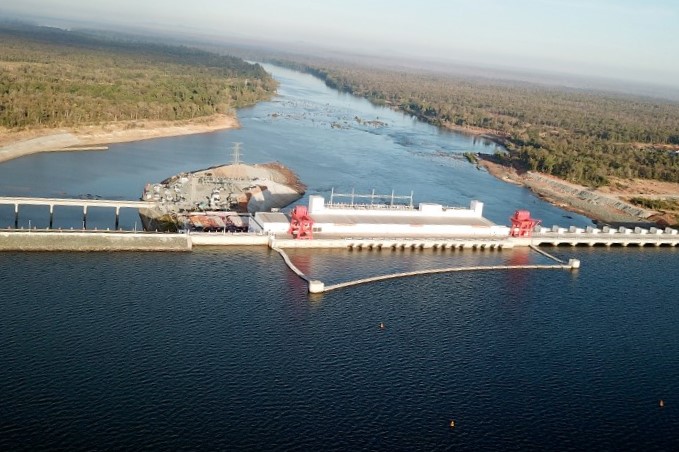English-Français

A general view of the Cambodia's 400 megawatt Lower Sesan 2 hydroelectric dam is seen during the inauguration in Stung Treng province on December 17, 2018 (AFP)
×![]()
Phnom Penh| Frequent droughts, longer dry seasons and heat waves, are seen making reliance on hydropower risky.
Power outages are triggering outrage among Cambodians as they blame the government for being unable to ensure sustainable electricity supplies.
The government is currently reducing supply during the day and urging the public to understand.
With Prime Minister Hun Sen saying the cuts will continue until June, the government has leased a power-generating ship from Turkey to tackle the shortage.
Energy Economist at the Economic Research Institute for ASEAN and East Asia (ERIA), Han Phoumin says the shortage reflects the large share of hydropower in Cambodia’s energy mix and lower water levels in this year’s dry season.
“Cambodia has a very high share of hydropower, and they are subjected to seasonal efforts depending on the water in the reservoir. It is very unfortunate that this is a dry season with high electricity demand, and thus we experience shortages of electricity,” he said.
According to the Ministry of Mines and Energy, hydropower supplies up to 45 percent of Cambodia’s electricity.
Climate change can cause dam failures
The government aims to achieve 100 percent electrification nationwide by 2020, according to the Cambodian National Strategic Development Plan 2014-2018.
Coal and hydropower are considered the most reliable and affordable sources of power as consumption increases in line with rapid economic growth.
According to the Cambodia Basic Energy Plan, prepared by the Ministry of Mines and Energy and the Economic Research Institute for ASEAN and East Asia (ERIA), electricity demand is projected to grow by an annual average of nine percent between 2015 and 2040.
At the same time, Cambodia is expected to experience frequent droughts, longer dry seasons and heat waves due to the intensifying impacts of climate change, making reliance on hydropower risky.
Sar Mory, co-founder of the Cambodian Youth Network, warns that increased rainfall could also lead to dam failures, citing recent collapses in Laos and Brazil.
Han Phoumin said Cambodia’s grid must be upgraded to allow for a larger share of clean power.
“Of course, Cambodia can promote more solar power, but the current power grid may not be able to hold the higher share of renewable energy from solar,” he said. “Nonetheless, solar can be promoted if it can be stand-alone solar farms.”
Cambodia should consider increasing “more stable base-loaded power generation”, helping to reduce the dependency on hydropower, he said.
“Cambodia will need to consider using natural gas power plants combining with coal, hydropower, solar and biomass power plants. In this way, we can cope with the large reductions of electricity from hydropower during the hot season,” he explains.
However, he warns that increasing use of more coal power will be difficult as it is not as “flexible as gas power generation, which can back up during peak or non-peak hours”.
Energy demand drives CO2 emissions
The energy plan notes that Cambodia will also see an increase in CO2 emissions driven by the intensification of energy demand.
“CO2 emissions will increase by 5.6% per year from 1.96 million tonnes of carbon in 2015 to 8.62 million tonnes of carbon in 2040 under the business-as-usual scenario,” it says.
More coal for power generation and strong demand in the transport sector are the main drivers of surging CO2 emissions, the report adds.
It can be anticipated that more coal power plants will be built to cope with rising energy demands.
But prioritizing coal power is likely to affect Cambodia’s commitment to achieving the CO2 reduction under the 2015 Paris Climate Agreement.
Under the accord, Cambodia pledges to cut emissions by 3,100 gigagrams of “carbon dioxide equivalent” by 2030, 1,800 gigagrams of which is from energy industries.
Han Phoumin suggests that improving energy efficiency is key to reducing emissions.
“Cambodia needs to develop a concrete action plan and policy to implement energy efficiency and conservation in all sectors, especially power generation and transportation. For power generation, it needs to deploy high efficiency and low-emission power generation,” he says.
Sar Mory says the government must do more to improve energy efficiency.
“The government prioritizes coal and hydropower for power generation, but these two sources are not the only choice or solution we have. We have other alternatives like renewable energy that we need to focus on. But the problem is whether we want to invest in it or not,” he says.
© រក្សាសិទ្ធិដោយ thmeythmey.com






















